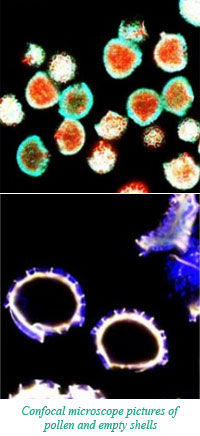Shell Production
This is the process of emptying the genetic material from the pollen/spores to leave a shell capable of being refilled with active ingredients.
 There are many methods of emptying the pollen / spores. The most appropriate will depend upon the type of pollen and the eventual use of the shell. For micro-encapsulation it is important that the shell remains relatively intact. Some plants produce pollens that are more robust than others, so a procedure that is quick and effective for one species may need to be slower and milder with another. In addition the colour and anti-oxidant properties of the shells are affected by the extraction process.
There are many methods of emptying the pollen / spores. The most appropriate will depend upon the type of pollen and the eventual use of the shell. For micro-encapsulation it is important that the shell remains relatively intact. Some plants produce pollens that are more robust than others, so a procedure that is quick and effective for one species may need to be slower and milder with another. In addition the colour and anti-oxidant properties of the shells are affected by the extraction process.
Sporomex can provide advice in optimising the process for a particular use and if specific labelling of the product is required. In general the process is very simple and may be a single stage procedure (see for example UK Patent application 0720260.9). An acid or enzyme treatment will remove most of the central material leaving the intine (mainly cellulose) and exine (sporopollenin) shells. This removes the protein and hence any possible allergenic material.
For some purposes it is desirable to also remove the intine layer. This can be carried out by an alkali treatment and leaves a shell composed largely of sporopollenin. The actual structure of this material is not known, but it appears to be an oxidative polymer of carotenoid character. It is composed almost entirely of carbon, hydrogen and oxygen and has an empirical formula of ca C90H144O27 (i.e. Carbon 3 : Hydrogen 5 : Oxygen 1). The shell thickness is usually 1 - 2 micron.
When the loaded powder is used in cosmetics and some foods, it is sometimes necessary for its colour to be very light, so that the individual particles are not seen as specks within the product. This can sometimes be achieved by bleaching, following the initial extraction. At other times the initial extraction must be modified to prevent the formation of dark colours. The actual process chosen will depend upon the original pollen, the required anti-oxidant properties and the need to maintain an intact shell. A range of colours for Lycopodium clavatum shells is illustrated below and further details are available in patent PCT/GB2009/050813
Colour Measurement
